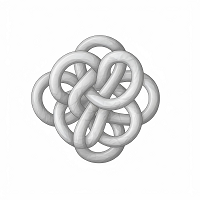The Equivalence Problem


We can contemplate a fundamental question. When presented with two knots exhibiting intricate twistings and tanglings, more complex than the previous example, how can we distinguish between them? For instance, consider the knots depicted above; they are significantly more intricate. The challenge lies in determining whether these knots are essentially the same or distinct entities.
One approach could involve physically attempting to untangle and simplify the complexity. If successful in transforming them into unknots, we can assert that both knots are identical, mere unknots obscured by intricate deformations. However, the task becomes formidable in cases where the complexity is immense, leading us to endlessly untangle twists without certainty. The challenge deepens when determining whether two knots, despite different appearances, are indeed the same or vice versa—two seemingly identical knots may turn out to be distinct.
We can pose the same questions for links as we did for knots—how to determine if two complex links are the same or different, and so on. As we possess the liberty to augment the complexity of knots and links at will, providing definitive answers to these questions becomes a herculean task.
Thanks to all the mathematicians who have developed the profound Knot Theory, a sub-branch of the field Topology, to address these questions. In this area, all knots (trivial and non-trivial) and links (trivial and non-trivial) are identified as topological spaces, and their different topological invariants are computed and then compared to determine whether the two knots or links are equivalent or not.
A General Outline of How Knot Theory Deals with the Equivalence Problem
We take two knots, K1 and K2. Suppose they are different knots, but we are not told about it. So where and how do we start?
We can regard both of these knots as two topological spaces as they satisfy all the necessary conditions to be so. As we have discussed in the previous section, topological properties or invariants of topological spaces do not change under homeomorphism or continuous deformations. No matter how we deform both of them, their topologically invariant properties, TI 1 and TI 2 respectively, do not and will not change.
The only way to change those properties is when we change them into different structures. The property is like an Aadhaar Card (a personal identification card for every Indian Citizen issued by the Government of India) for the knot. Thus, different topological invariants imply that the two knots are different for sure.
Based on this, we compute the topological invariants for both knots and then compare them. If they are equal, they can be the same or different—it does not matter much—but if they are different, we know for sure that the knots are different. The same idea works for links. Links with different topological properties are different.
Thus, the topological properties TI 1 and TI 2 of knots K1 and K2 respectively will come out different on computing, and that is how we can prove that these knots are different.